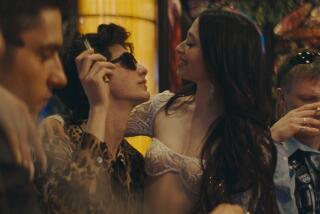For Him, Bike Is Not a Toy
- Share via
Remember your first bicycle?
It probably arrived under the Christmas tree with a red bow on the handle bars. Right?
Mine did.
It took me about a year to get the training wheels off, but then I was only in the fourth grade. After that, I customized it to my own taste.
It had a headlight.
It had a bell.
It had little streamers coming off the grips.
And it had saddle bags for carrying frogs, turtles and, infrequently, textbooks.
Naturally, I rode the bike to school, causing my mother to admonish me that kids were not that lazy in the old days. It seemed bicycles were perceived as modern contraptions of convenience, depriving children of the benefits of a brisk walk to class.
And adults never rode bicycles.
Much has changed for the bicycle and its riders.
Indeed, bicycles now symbolize fitness. For heaven’s sake, adults ride them. An adult who rides to work is considered environmentally aware and probably as healthy as when he or she found that first bike Christmas morning.
That’s how Arnie Baker started riding.
To work.
In Montreal.
Even in the winter.
“It was a form of transportation,” he said. “The concept of riding for fun was quite strange . . . until we moved to California.”
It can’t be said Baker rides for fun these days. Sure, he has fun riding, but his cycling has swiftly climbed the hill from healthy transportation to invigorating recreation to downright vigorous competition.
Some might even suggest that Arnie Baker has turned into a little bit of a lunatic about bicycling, given his 200-mile-per-week training schedule.
“I’d like to ride more,” he said, almost apologetically. “Actually, I have to work for a living, too.”
He makes a living as a family practice physician and, yes, he rides to work. In fact, he was pleased when his office was relocated from the Hillcrest area to closer to downtown so he had a longer commute.
The move to California came in 1981, but the move to recreational use of the bicycle did not come for a couple of years after that. Baker and his wife discovered that people did things such as take Saturday rides of between 10 and 15 miles.
Another thing he realized was that he was as strong as the other riders. This led to an adventure with a group called The Banana Gang, which proved to be a bunch of Top Banana types. But these rides implanted the notion that racing might be fun.
Baker started as an unlicensed rider, which was to say he was a novice without a rating. He did to this level of riding what The Banana Gang did to him--overmatched it. He won his first six races. He moved up to Category 4 in all of one weekend and now finds himself at Category 2, one level below what might be called world class.
Baker, at 36, may not be a candidate for the 1992 Olympics, but he will be in the midst of the National Masters Championships that begin in San Diego today and run (or ride) for nine days. There are seven disciplines, and he is entered in all of them, though he says, apologetically again, that he will likely only compete in six.
“The times trials are the day before the 1K,” he explained. “It would be very hard to ride 40 kilometers all out and then come back the next day to ride an event that requires such short bursts of speed. It would be like trying to do a 200-meter dash the day after a marathon.”
The thing is that these people, these cyclists, can be competitive in such a wide variety of disciplines. Imagine anyone even thinking of a marathon/200-meter sweep in any given year, much less back-to-back days.
Yes, cycling has changed since that red ribbon under the Christmas tree.
Seven different events will be contested here, beginning today with the criterium around the San Diego Administration Building on Harbor Drive. It continues with time trials in Mexico, four different track events at the Morley Field Velodrome and a road race in Balboa Park.
No, one bicycle will not do. One bicyclist, yes. But not one bicycle.
In Baker’s home, bicycles and tubes and frames and wheels are spread out at one end of a living room large enough for a points race. A friend came by and picked up a tube (or was it a tire?) that looked like something a kid would pick up for $3.95 at a toy store.
Cost? Try $120 . . . or about $21 an ounce. At that price, he should take up caviar.
Baker himself will use four different bicycles. These things cost anywhere from $1,200 to as much as $3,000, and they don’t even come with tape decks, bucket seats and wet bars. As a matter of fact, they come so stripped down you can lift some of them with your pinky. Of course, you spend more tinkering with them once you get them.
On one bike, the doc was showing me two different gadgets that I was assuming were either radios or mini-televisions. You know, something to break the monotony. In reality, they gave him digital readouts on things such as speed, distance, revolutions per minute, heart rate and, presumably, whether Smokey was hiding behind that billboard ahead.
I almost asked.
But I resisted.
I couldn’t figure where he carried the frogs.
More to Read
Sign up for Essential California
The most important California stories and recommendations in your inbox every morning.
You may occasionally receive promotional content from the Los Angeles Times.













